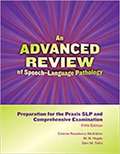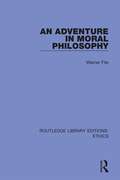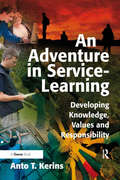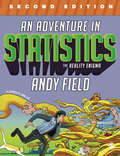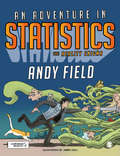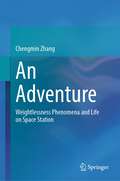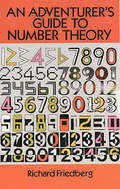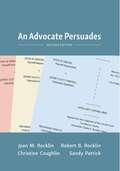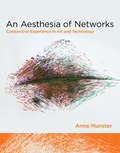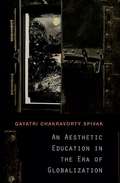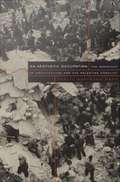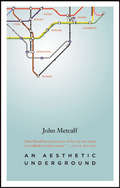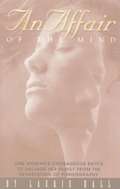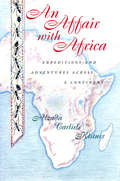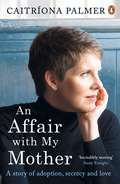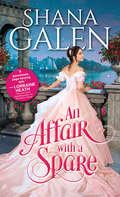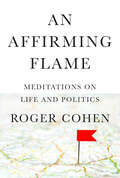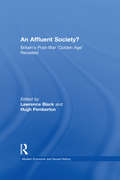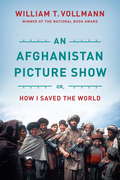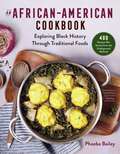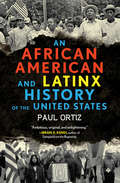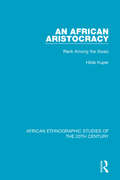- Table View
- List View
An Advanced Review Of Speech-Language Pathology: Preparation For The Praxis SLP And Comprehensive Examination
by M. N. Hegde Celeste Roseberry-McKibbin Glen M. TellisThe #1 choice for Praxis SLP preparation! Get excellent Praxis SLP preparation with this comprehensive review, study guide, textbook, online practice exams, and reference, all in one! Brand new for 2019, this text extracts the most current, important, and relevant information from the entire field of speech-language pathology and includes it for your review. Simulate the most current Praxis exam experience with the completely revised Online Practice Exams. These interactive, web-based practice tests include questions from three content categories: foundations and professional practice screening, assessment, evaluation, and diagnosis planning, implementation, and evaluation of treatment The included online subscription allows you to take twelve full-length exams and additional short, topic-targeted tests. After completing a test, review your score, total time taken to test, average time per question, total score, number of incorrect answers, and percentage of correct answers. Your correct and incorrect attempt for each topic (e.g., anatomy, voice, etc.) will also be displayed. Additionally, you will receive an analysis of your results, a comparison of your scores over multiple administrations, and a comparison with the scores of test takers from across the country. Get the most out of your study time--take an exam, identify areas that need additional study, review the materials, and repeat the exam. New information includes: Common Core State Standards with links to suggestions for how speech language pathologists can help children with language impairments achieve the standards iPad apps with suggestions for use with persons with communication disorders Pediatric dysphagia Telepractice Appendix of helpful suggestions to prepare for and take the new Praxis examination Experienced professionals will find this text an excellent
An Adventure In Moral Philosophy
by Warner FiteOriginally published in 1926, this book develops the Socratic thesis that morality is intelligence, that morality is not a matter of standards, laws and principles but in knowing what we do – in living self-consciously. The book develops this central theme in its bearings upon logic and science, art and religion and suggests that both intelligence and morality stand for much more than appears first obvious.
An Adventure in Service-Learning: Developing Knowledge, Values and Responsibility
by Anto T. KerinsAn Adventure in Service-Learning argues that education can provide not just knowledge and skills but it can also encourage the development of values and responsibility Service-Learning is a teaching method unlike any other. It allows students to use their classroom theory to help others through relevant service or volunteering activity. In so doing, it gives students the opportunity to use the experiences of helping others to strengthen their understanding of subject material. Service-learning is like a bridge that connects education with the outside world. It breathes life and clarity into any subject and better prepares students for life after college. An Adventure in Service-Learning is a well written and easy to read book. It introduces the newcomer to service-learning and provides the seasoned practitioner with an important analysis of this most interesting of teaching methods. Its discussion of learning and the role of higher education will interest educationalists and its consideration of service will be important to those who are concerned about community. A passionate belief in education and its possibilities permeates An Adventure in Service-Learning. The book examines service-learning in project management, leadership and management consultancy and provides readers with an understanding of how the method can work in any subject or discipline. It clarifies the need for community and discusses the nature and possibilities of what it means to be human. The book will help to renew and reinvigorate practitioners, policy makers and the education system as a whole.
An Adventure in Statistics: The Reality Enigma
by Andy FieldAPEX Award 2023 for Publication Excellence: Print Media - Education & Training Shortlisted for the British Psychological Society Book Award 2017 Shortlisted for the British Book Design and Production Awards 2016 Shortlisted for the Association of Learned & Professional Society Publishers Award for Innovation in Publishing 2016 Now in its second edition, An Adventure in Statistics: The Reality Enigma by best-selling author and award-winning teacher Andy Field offers a better way to learn statistics. It combines rock-solid statistics coverage with compelling visual storytelling to address the conceptual difficulties that students learning statistics for the first time often encounter in introductory courses. Students are guided away from rote memorization towards independent, critical thinking and problem solving. This essential foundation to understanding statistics is woven into the unique action-packed story of Zach, who thinks, processes information and faces challenges to his understanding in the same way as a statistics novice. Illustrated with stunning, graphic novel-style art and featuring Socratic dialogue, the story captivates readers as it introduces them to concepts, eliminating potential statistics anxiety. No previous statistics knowledge is presumed, and no use of data analysis software is required – everything you would expect for an introductory course is covered but with a contemporary twist, arming students with a strong grounding in understanding classical and Bayesian approaches to data analysis. With its unique combination of story, concepts and terminology, this complete introduction to statistics from bestselling author Andy Field breaks the mould to present a statistical tale like no other. Stay connected Join us on Facebook and share your experiences with Andy’s texts, check out news, access free stuff, see photos, watch videos, learn about competitions, and much more.
An Adventure in Statistics: The Reality Enigma
by Andy FieldAPEX Award 2023 for Publication Excellence: Print Media - Education & Training Shortlisted for the British Psychological Society Book Award 2017 Shortlisted for the British Book Design and Production Awards 2016 Shortlisted for the Association of Learned & Professional Society Publishers Award for Innovation in Publishing 2016 Now in its second edition, An Adventure in Statistics: The Reality Enigma by best-selling author and award-winning teacher Andy Field offers a better way to learn statistics. It combines rock-solid statistics coverage with compelling visual storytelling to address the conceptual difficulties that students learning statistics for the first time often encounter in introductory courses. Students are guided away from rote memorization towards independent, critical thinking and problem solving. This essential foundation to understanding statistics is woven into the unique action-packed story of Zach, who thinks, processes information and faces challenges to his understanding in the same way as a statistics novice. Illustrated with stunning, graphic novel-style art and featuring Socratic dialogue, the story captivates readers as it introduces them to concepts, eliminating potential statistics anxiety. No previous statistics knowledge is presumed, and no use of data analysis software is required – everything you would expect for an introductory course is covered but with a contemporary twist, arming students with a strong grounding in understanding classical and Bayesian approaches to data analysis. With its unique combination of story, concepts and terminology, this complete introduction to statistics from bestselling author Andy Field breaks the mould to present a statistical tale like no other. Stay connected Join us on Facebook and share your experiences with Andy’s texts, check out news, access free stuff, see photos, watch videos, learn about competitions, and much more.
An Adventure in Statistics: The Reality Enigma
by Professor Andy FieldShortlisted for the British Psychological Society Book Award 2017 Shortlisted for the British Book Design and Production Awards 2016 Shortlisted for the Association of Learned & Professional Society Publishers Award for Innovation in Publishing 2016 An Adventure in Statistics: The Reality Enigma by best-selling author and award-winning teacher Andy Field offers a better way to learn statistics. It combines rock-solid statistics coverage with compelling visual story-telling to address the conceptual difficulties that students learning statistics for the first time often encounter in introductory courses - guiding students away from rote memorization and toward critical thinking and problem solving. Field masterfully weaves in a unique, action-packed story starring Zach, a character who thinks like a student, processing information, and the challenges of understanding it, in the same way a statistics novice would. Illustrated with stunning graphic novel-style art and featuring Socratic dialogue, the story captivates readers as it introduces them to concepts, eliminating potential statistics anxiety. The book assumes no previous statistics knowledge nor does it require the use of data analysis software. It covers the material you would expect for an introductory level statistics course that Field’s other books (Discovering Statistics Using IBM SPSS Statistics and Discovering Statistics Using R) only touch on, but with a contemporary twist, laying down strong foundations for understanding classical and Bayesian approaches to data analysis. In doing so, it provides an unrivalled launch pad to further study, research, and inquisitiveness about the real world, equipping students with the skills to succeed in their chosen degree and which they can go on to apply in the workplace. The Story and Main Characters The Reality Revolution In the City of Elpis, in the year 2100, there has been a reality revolution. Prior to the revolution, Elpis citizens were unable to see their flaws and limitations, believing themselves talented and special. This led to a self-absorbed society in which hard work and the collective good were undervalued and eroded. To combat this, Professor Milton Grey invented the reality prism, a hat that allowed its wearers to see themselves as they really were - flaws and all. Faced with the truth, Elpis citizens revolted and destroyed and banned all reality prisms. The Mysterious Disappearance Zach and Alice are born soon after all the prisms have been destroyed. Zach, a musician who doesn’t understand science, and Alice, a geneticist who is also a whiz at statistics, are in love. One night, after making a world-changing discovery, Alice suddenly disappears, leaving behind a song playing on a loop and a file with her research on it. Statistics to the Rescue! Sensing that she might be in danger, Zach follows the clues to find her, as he realizes that the key to discovering why Alice has vanished is in her research. Alas! He must learn statistics and apply what he learns in order to overcome a number of deadly challenges and find the love of his life. As Zach and his pocket watch, The Head, embark on their quest to find Alice, they meet Professor Milton Grey and Celia, battle zombies, cross a probability bridge, and encounter Jig:Saw, a mysterious corporation that might have something to do with Alice’s disappearance… Author News "Eight years ago I had the idea to write a fictional story through which the student learns statistics via a shared adventure with the main character..." Read the complete article from Andy Field on writing his new book Times Higher Education article: “Andy Field takes statistics adventure to a new level” Stay Connected Connect with us on Facebook and share your experiences with Andy’s texts, check out news, access free stuff, see photos, watch videos, learn about competitions, and much more. Video Links Go behind the scenes and learn more about the man behind the book: Watch Andy talk about why he created a statistics book using the framework of a novel and illustratio
An Adventure: Weightlessness Phenomena And Life On Space Station
by Chengmin ZhangThis is a popular science book surrounding astronauts’ life on the space station. The book not only highlights the weightlessness experience of astronauts and the extraordinary phenomena they witness, but also illustrates the physics behind these events, which opens a new window for readers to explore the outer space. This book is especially fun for those who are curious about the life details of astronauts on the space station. The book is based on real events, and features images and cartoons that vividly depict unusual scenes between the outer space and the earth. Physical principles become easier to understand with these visual aids. During the reading, readers can immerse themselves in the enjoyable adventure of space travel and the strange feeling of weightlessness while having their doubts of every oddity solved. The book elaborates on the interesting contrast between the space and the earth, and provides readers with a stunning new perspective with easily comprehensible language and examples.
An Adventurer's Guide to Number Theory (Dover Books On Mathematics Ser.)
by Richard FriedbergIn this delightful guide, a noted mathematician and teacher offers a witty, historically oriented introduction to number theory, dealing with properties of numbers and with numbers as abstract concepts. Written for readers with an understanding of arithmetic and beginning algebra, the book presents the classical discoveries of number theory, including the work of Pythagoras, Euclid, Diophantus, Fermat, Euler, Lagrange and Gauss.Unlike many authors, however, Mr. Friedberg encourages students to think about the imaginative, playful qualities of numbers as they consider such subjects as primes and divisibility, quadratic forms and residue arithmetic and quadratic reciprocity and related theorems. Moreover, the author has included a number of unusual features to challenge and stimulate students: some of the original problems in Diophantus' Arithmetica, proofs of Fermat's Last Theorem for the exponents 3and 4, and two proofs of Wilson's Theorem.Readers with a mathematical bent will enjoy and benefit from these entertaining and thought-provoking adventures in the fascinating realm of number theory. Mr. Friedberg is currently Professor of Physics at Barnard College, where he is Chairman of the Department of Physics and Astronomy.
An Advocate Persuades
by Christine Coughlin Joan Rocklin Sandy Patrick Robert RocklinAn Advocate Persuades introduces its reader to the role of the advocate and the tools of persuasion. This book, like its predecessor A Lawyer Writes, places the reader in the role of a first-year attorney. Now, that first-year attorney must draft a motion or appellate brief and then present an oral argument. With step-by-step explanations and numerous examples, An Advocate Persuades explains how to develop and refine trial-level and appellate arguments and then how to present those arguments orally. Speaking to its readers in a straightforward manner, An Advocate Persuades communicates both the theories and foundational skills of persuasion so that they will be retained for a lifetime of legal practice.
An Advocate Persuades
by Christine Coughlin Joan Rocklin Sandy Patrick Robert RocklinThe second edition of An Advocate Persuades is reorganized into four parts: (1) Introduction to Advocacy; (2) Developing Arguments from a Persuasive Perspective; (3) Constructing Persuasive Court Documents (both at the trial and appellate level); and (4) Oral Argument (both at the trial and appellate level). The book also has an expanded appendix, which provides an overview of trial and appellate litigation in both civil and criminal cases, annotated trial and appellate briefs, and advice about moot court competitions.
An Aesthesia of Networks
by Anna MunsterToday almost every aspect of life for which data exists can be rendered as a network. Financial data, social networks, biological ecologies: all are visualized in links and nodes, linesconnecting dots. A network visualization of a corporate infrastructure could look remarkably similarto that of a terrorist organization. In An Aesthesia of Networks, Anna Munsterargues that this uniformity has flattened our experience of networks as active and relationalprocesses and assemblages. She counters the "network anaesthesia" that results from thispervasive mimesis by reinserting the question of experience, or aesthesia, into networked cultureand aesthetics. Rather than asking how humans experience computers and networks, Munster asks hownetworks experience -- what operations they perform and undergo to change andproduce new forms of experience. Drawing on William James's radical empiricism, she asserts thatnetworked experience is assembled first and foremost through relations, which make up its mostimmediately sensed and perceived aspect. Munster critically considers a range of contemporaryartistic and cultural practices that engage with network technologies and techniques, includingdatabases and data mining, the domination of search in online activity, and the proliferation ofviral media through YouTube. These practices -- from artists who "undermine" data tomusicians and VJs who use intranetworked audio and video software environments -- are concerned withthe relationality at the core of today's network experience.
An Aesthesia of Networks: Conjunctive Experience in Art and Technology (Technologies of Lived Abstraction)
by Anna MunsterThe experience of networks as the immediate sensing of relations between humans and nonhuman technical elements in assemblages such as viral media and databases.Today almost every aspect of life for which data exists can be rendered as a network. Financial data, social networks, biological ecologies: all are visualized in links and nodes, lines connecting dots. A network visualization of a corporate infrastructure could look remarkably similar to that of a terrorist organization. In An Aesthesia of Networks, Anna Munster argues that this uniformity has flattened our experience of networks as active and relational processes and assemblages. She counters the “network anaesthesia” that results from this pervasive mimesis by reinserting the question of experience, or aesthesia, into networked culture and aesthetics.Rather than asking how humans experience computers and networks, Munster asks how networks experience—what operations they perform and undergo to change and produce new forms of experience. Drawing on William James's radical empiricism, she asserts that networked experience is assembled first and foremost through relations, which make up its most immediately sensed and perceived aspect. Munster critically considers a range of contemporary artistic and cultural practices that engage with network technologies and techniques, including databases and data mining, the domination of search in online activity, and the proliferation of viral media through YouTube. These practices—from artists who “undermine” data to musicians and VJs who use intranetworked audio and video software environments—are concerned with the relationality at the core of today's network experience.
An Aesthetic Education in the Era of Globalization
by Gayatri Chakravorty SpivakDuring the past twenty years, the world s most renowned critical theorist the scholar who defined the field of postcolonial studies has experienced a radical reorientation in her thinking. Finding the neat polarities of tradition and modernity, colonial and postcolonial, no longer sufficient for interpreting the globalized present, she turns elsewhere to make her central argument: that aesthetic education is the last available instrument for implementing global justice and democracy. Spivak s unwillingness to sacrifice the ethical in the name of the aesthetic, or to sacrifice the aesthetic in grappling with the political, makes her task formidable. As she wrestles with these fraught relationships, she rewrites Friedrich Schiller s concept of play as double bind, reading Gregory Bateson with Gramsci as she negotiates Immanuel Kant, while in dialogue with her teacher Paul de Man. Among the concerns Spivak addresses is this: Are we ready to forfeit the wealth of the world s languages in the name of global communication? Even a good globalization (the failed dream of socialism) requires the uniformity which the diversity of mother-tongues must challenge, Spivak writes. The tower of Babel is our refuge. In essays on theory, translation, Marxism, gender, and world literature, and on writers such as Assia Djebar, J. M. Coetzee, and Rabindranath Tagore, Spivak argues for the social urgency of the humanities and renews the case for literary studies, imprisoned in the corporate university. Perhaps, she writes, the literary can still do something. "
An Aesthetic Occupation
by Daniel Bertrand MonkIn An Aesthetic Occupation Daniel Bertrand Monk unearths the history of the unquestioned political immediacy of "sacred" architecture in the conflict between Palestinians and Israelis. Monk combines groundbreaking archival research with theoretical insights to examine in particular the Mandate era--the period in the first half of the twentieth century when Britain held sovereignty over Palestine. While examining the relation between monuments and mass violence in this context, he documents Palestinian, Zionist, and British attempts to advance competing arguments concerning architecture's utility to politics. Succumbing neither to the view that monuments are autonomous figures onto which political meaning has been projected, nor to the obverse claim that in Jerusalem shrines are immediate manifestations of the political, Monk traces the reciprocal history of both these positions as well as describes how opponents in the conflict debated and theorized their own participation in its self-representation. Analyzing controversies over the authenticity of holy sites, the restorations of the Dome of the Rock, and the discourse of accusation following the Buraq, or Wailing Wall, riots of 1929, Monk discloses for the first time that, as combatants looked to architecture and invoked the transparency of their own historical situation, they simultaneously advanced--and normalized--the conflict's inability to account for itself. This balanced and unique study will appeal to anyone interested in Israel or Zionism, the Palestinians, the Middle East conflict, Jerusalem, or its monuments. Scholars of architecture, political theory, and religion, as well as cultural and critical studies will also be informed by its arguments.
An Aesthetic Underground
by John Metcalf"John Metcalf has written some of the very best stories ever published in this country."--Alice MunroThe Argus-eyed editor; the magisterial prose stylist; the waggish, inflammatory cultural critic; the mentor and iconoclast. John Metcalf is a literary legend whose memoir maps the underground he labored tirelessly to establish.
An Affair of the Mind: One Woman's Courageous Battle to Salvage Her Family from the Devastation of Pornography
by Laurie HallWhen You're Blinded by Lust, You See No Evil ... It began with a casual glance at a girlie magazine but turned into something far more insidious. "Innocent" fascination with softcore pornography eventually led to skin flicks, frequent visits to strip clubs, and encounters with prostitutes. Jack Hall's secret obsession was just that-a secret. And right before her eyes, Laurie watched her husband dissolve into a shadow of the man she loved. None of it made sense. Compelling and poignant, An Affair of the Mind tells the story of one woman's struggle to protect herself and her children from the devastating effects of pornography. With both candor and sensitivity, Laurie Hall relives the nightmare that nearly destroyed her family, warning others of porn's seductive, addictive nature. She opens her heart and bares her soul, imparting keen insights and comfort. And she shares the hard lessons God taught her-among them, the virtues of patience, trust, and perseverance.
An Affair with Africa: Expeditions and Adventures Across a Continent
by Alzada Carlisle KistnerIn June 1960, a young faculty wife named Alzada Kistner and her husband David, a promising entomologist, left their 18-month old daughter in the care of relatives and began what was to be a four month scientific expedition in the Belgian Congo. Three weeks after their arrival, the country was gripped by a violent revolution trapping the Kistners in its midst. Despite having to find their way out of numerous life-threatening situations, the Kistners were not to be dissuaded. An emergency airlift by the United States Air Force brought them to safety in Kenya where they continued their field work.Thus began three decades of adventures in science. In An Affair with Africa, Alzada Kistner describes her family's African experience -- the five expeditions they took beginning with the trip to the Belgian Congo in 1960 and ending in 1972-73 with a nine-month excursion across southern Africa. From hunching over columns of ants for hours on end while seven months pregnant to eating dinner next to Idi Amin, Kistner provides a lively and humor-filled account of the human side of scientific discovery. Her wonderfully detailed stories clearly show why, despite hardship and danger -- and contrary to all of society's expectations -- she could not forsake accompanying her husband on his expeditions, and, to this day, continues to find the world "endlessly beckoning, a lively bubbling cauldron of questions and intrigue."In the spirit of Beryl Markham's West with the Night and Isak Dinesen's Out of Africa, An Affair with Africa shares with readers the thoughts and experiences of a remarkable woman, one whose unquenchable thirst for adventure led her into a series of almost unimaginable situations. Readers -- from armchair travelers fascinated by stories of Africa to scientists familiar with the Kistners's work but unaware of the lengths to which they went to gather their data -- will find An Affair with Africa a rare treasure.
An Affair with My Mother: A Story of Adoption, Secrecy and Love
by Caitríona Palmer'Incredibly moving' --Anne Enright, winner of the Man Booker PrizeAn Affair with My Mother by Caitriona Palmer: a moving and gripping story of love, denial and a daughter's quest for the truth.Caitriona Palmer had a happy childhood in Dublin, raised by loving adoptive parents. But when she was in her late twenties, she realized that she had a strong need to know the woman who had given birth to her. She was able to locate her birth mother, Sarah, and they developed a strong attachment. But Sarah set one painful condition to this joyous new relationship: she wished to keep it - to keep Caitriona - secret from her family, from her friends, from everyone. Who was Sarah, and why did she want to preserve a decades-old secret? An Affair with My Mother tells the story of Caitriona's quest to answer these questions, and of the intense, furtive 'affair' she and her mother conducted in carefully chosen locations around Dublin. By turns heartwarming and heartbreaking, An Affair with My Mother is a searing portrait of the social and familial forces that left Sarah - and so many other unwed Irish mothers of her generation - frightened, traumatized and bereft. It is also a beautifully written account of a remarkable relationship.'Caitriona Palmer has called out the false shame of her origins, with a kind of anguished courage that is incredibly moving. An Affair With My Mother is a forensic account of how it feels to be - in the interests of Catholic "respectability" - excluded from the facts of your own life. In its commitment to family love, to joy and truth, it is a gift.' Anne Enright, winner of the Man Booker Prize
An Affair with a Spare (Survivors Ser. #3)
by Shana GalenRafe Beaumont, fifth son of an earl, uses his irresistible charm with the ladies to glean dangerous war secrets. Now he’s putting those skills to the ultimate test: capturing an elusive assassin by seducing his daughter. The problem? She’s entirely immune to Rafe’s flattery. <P><P> Never before has Collette Fortier met a man as attractive as Rafe. But her father’s life is at stake, and succumbing to Rafe would be disastrous. But when Rafe turns the tables on her, offering support and friendship instead of a fleeting affair, Collette finds herself tempted in ways she never could have imagined…
An Affirming Flame: Meditations on Life and Politics
by Roger Cohen&“For more than forty years Roger Cohen has ventured to every corner of the earth to chronicle the great upheavals of our age, but he&’s never lost sight of what really matters: love, hope, and all the mysteries of the human heart. Here, in this collection of columns that will take you from the streets of Kyiv to an execution chamber in Alabama, you can read him at his best.&”—Dexter Filkins, best-selling author of The Forever WarA collection of the finest New York Times columns written by Roger Cohen over more than a decade, accompanied by an original, twenty-thousand-word essay on the state of the worldThe countless readers who followed Roger Cohen&’s column and mourned its end responded above all to what they saw as the marriage in his writing of head and heart. That tenor permeates An Affirming Flame.During his twelve years as a columnist, Cohen aimed to hold power to account at home and abroad, in the name of freedom, decency, pluralism, and the importance of truth and dissent in open societies. He watched with alarm as the outside threat of 9/11 morphed into the internal threat of January 6. This time, the assailants were not jihadi terrorists; they were American white supremacists and seditionists convinced of American decadence but unable to see that they personified it. The threat to American democracy is clear.Cohen dissects this ominous American fracture. He explores themes of displacement, belonging, and his own imperiled craft of journalism. His examination of the rising tide of authoritarian rule takes him to China, and in Kyiv he sees the devastating impact of Vladimir Putin's Russian nationalism. With its trenchant consideration of the plight of refugees, COVID-19, the Israeli-Palestinian conflict, and the war in Afghanistan, Cohen's writing reflects his belief in the unquenchable human quest for dignity.He captures the fight to defend America&’s openness, democratic institutions, and ideals against the rising tide of retrogression, division, and assault on truth. This struggle, as Cohen writes, is also the world&’s. It is inseparable from the battle to save humanity from the creeping autocracy of the twenty-first century. As he writes, &“On lies is tyranny built.&”
An Affluent Society?: Britain's Post-War 'Golden Age' Revisited (Modern Economic and Social History)
by Lawrence Black Hugh PembertonDuring an election speech in 1957 the Prime Minister, Harold Macmillan, famously remarked that 'most of our people have never had it so good'. Although taken out of context, this phrase soon came to epitomize the sense of increased affluence and social progress that was prevalent in Britain during the 1950s and 1960s. Yet, despite the recognition that Britain had moved away from an era of rationing and scarcity, to a new age of choice and plenty, there was simultaneously a parallel feeling that the nation was in decline and being economically outstripped by its international competitors. Whilst the study of Britain's postwar history is a well-trodden path, and the paradox of absolute growth versus relative decline much debated, it is here approached in a fresh and rewarding way. Rather than highlighting economic and industrial 'decline', this volume emphasizes the tremendous impact of rising affluence and consumerism on British society. It explores various expressions of affluence: new consumer goods; shifting social and cultural values; changes in popular expectations of policy; shifting popular political behaviour; changing attitudes of politicians towards the electorate; and the representation of affluence in popular culture and advertising. By focusing on the widespread cultural consequences of increasing levels of consumerism, emphasizing growth over decline and recognizing the rising standards of living enjoyed by most Britons, a new and intriguing window is opened on the complexities of this 'golden age'. Contrasting growing consumer expectations and demands against the anxieties of politicians and economists, this book offers all students of the period a new perspective from which to view post-imperial Britain and to question many conventional historical assumptions.
An Afghanistan Picture Show
by William T. VollmannNever before available in paperback and all but invisible for twenty years, a personal account of the origins of America's longest war.In 1982, the young William Vollmann worked odd jobs, including as a secretary at an insurance company, until he'd saved up enough money to go to Afghanistan, where he wanted to join the mujahedeen to fight the Soviets. The resulting book wasn't published until 1992, and Library Journal wrote: "The wrong book written at the wrong time. . . . With the situation in Afghanistan rapidly heading toward resolution . . . libraries may safely skip this."Thirty years later--and with the United States still mired in the longest war of its history--it's time for a reassessment of Vollmann's heartfelt tale of idealism and its terrifying betrayals.An alloy of documentary and autobiographical elements characteristic of Vollmann's later nonfiction, An Afghanistan Picture Show is not a work of conventional reportage; instead, it's an account of a subtle and stubborn consciousness grappling with the limits of will and idealism imposed by violence and chaos.
An African American Cookbook: Exploring Black History and Culture Through Traditional Foods
by Phoebe Bailey400 Soul Food Recipes for Appetizers, Main Meals, Breads, Pies, Cakes, Salads, and More!An African American Cookbook: Exploring Black History and Culture Through Traditional Foods is a bountiful collection of favorite foods and the memories that go with them. The foods reflect the ingenious, resourceful, and imaginative Africans who made them. Woven among the four hundred recipes are rich historic anecdotes and sayings. They were discovered or lived by the cookbook&’s contributors, many of whose ancestors participated in the Underground Railroad or lived near where it was active. This is a cookbook rich in history and rich in easy-to-prepare, wonderfully tasty food! Recipes include: • Collard greens with ham hocks • Cornbread sausage stuffing • Smoked turkey and black-eyed peas • Pan-fried okra • Fried green tomatoes • 14-day sweet pickles • Yogurt and chives biscuits • Sweet potato pie • And more! Author Phoebe Bailey&’s congregation in historic Lancaster, Pennsylvania, has a long history with Underground Railroad activity. Today they offer Underground Railroad reenactments and a buffet of traditional African American food to their many visitors. This cookbook celebrates those historic events, when this church fed and then helped to spirit enslaved Africans to safety.
An African American and Latinx History of the United States
by Paul OrtizAn intersectional history of the shared struggle for African American and Latinx civil rightsSpanning more than two hundred years, An African American and Latinx History of the United States is a revolutionary, politically charged narrative history arguing that the “Global South” was crucial to the development of America as we know it. Ortiz challenges the notion of westward progress, as exalted by widely taught formulations such as “manifest destiny” and “Jacksonian democracy,” and shows how placing African American, Latinx, and Indigenous voices unapologetically front and center transforms American history into the story of the working class organizing against imperialism.In precise detail, Ortiz traces this untold history from the Jim Crow-esque racial segregation of the Southwest, the rise and violent fall of a powerful tradition of Mexican labor organizing in the twentieth century, to May 1, 2006, International Workers’ Day, when migrant laborers—Chicana/os, Afro-Cubanos, and immigrants from nearly every continent on earth—united in resistance on the first “Day Without Immigrants.”Incisive and timely, An African American and Latinx History of the United States is a bottom-up history told from the viewpoint of African American and Latinx activists and revealing the radically different ways people of the diaspora addressed issues still plaguing the United States today.
An African Aristocracy: Rank Among the Swazi
by Hilda KuperOriginally published in 1947 and reprinted with a new preface in 1961, this book is based on field studies and gives an account of the social organization of the Swazi, wiith special reference to the aristocratic structure of their society and the way in which birth and rank determine social relationships and activities. The book provides a historical picture of the Swazi and the part played by them during the period of European expansion in British and Boer conflicts in South Africa. The economic structure of a society based on agriculture and the influence exerted over every aspect of social activity by the conservative and aristocratic political hierarchy is analyzed and post-War changes and their effect upon the Swazi also reviewed.
